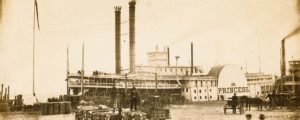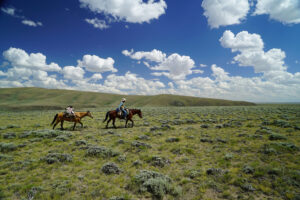Prospector George Lufkin and partner Chris Watson first scoured this remote valley for its rich silver ore in early 1878.Local John Miller grub staked the pair and promoted the strike, soon attracting regional attention.
By 1881 the district had drawn Eastern investors, who hired mining engineer George Daly to evaluate the site. Impressed, Daly bought the claims and formed the Sierra Grande Mining Co.with partners J. Whitaker Wright and George Roberts. They in turn attracted many well-known investors, including poet Walt Whitman.
In August 1881 blacksmith turned prospector John Leavitt discovered a fabulous silver lode. Just 40 feet beneath the surface he struck an opening with a mass of horn silver 4 feet thick that assayed an incredible 15,900 ounces of silver to the ton. It was one of the richest silver deposits in the world, producing more than2.5 million ounces of silver. Mine superintendent Bernard MacDonald named it the Bridal Chamber for the sparkling light reflected by cerargyrite crystals lining the cavern. The operators removed carloads of ore so pure they were shipped directly to the U.S. Mint. In sections of the claim miners cut silver from the walls with handsaws. One mass, dubbed “Jackson’s Baby” after mine manager D.H. Jackson,weighed more than 5 tons and had to be removed from the mine in pieces.
On the day the Bridal Chamber was discovered, Apaches ambushed and killed George Daly and several companions. Indian attacks were just one hazard miners faced,as the booming area also attracted rustlers and outlaws. Local legend has gunfighter “Longhair Jim”Courtright serving as town marshal,but he may have been just an ore guard for one of the district mines.
By 1882 the town the Bridal Chamber had spawned took the name Lake Valley.At its peak it had 1,000 residents, a dozen saloons, three churches, two newspapers,a school and several stores and hotels,while more than 400 mineshafts pocked the ground. Late that year George Roberts sold his interest in the Sierra Grande Mining Co. to Wright, as his association with the Great Diamond Hoax of 1872 (see October 2013 Wild West) had tarnished the company’s image. Wright was forced out within months.
By 1883 the area was thick with rustlers. The governor authorized the Territorial Militia to deal with them in anyway they deemed appropriate. Major Albert Jennings Fountain’s Las Cruces militia raided the town in early March, arresting two rustlers who were later gunned down while allegedly trying to escape.
The Santa Fe Railroad built a spur to Lake Valley in 1884, solidifying the town’s position as the district hub. But the Bridal Chamber’s ore was exhausted, and the Sierra Grande Co. discontinued development. Other companies continued operations, but rather than concentrating on average ores,they continued to search for the next bonanza. Thus they built expensive mills and smelters designed to handle high-grade ores while overlooking steadily profitable deposits.
As the ores decreased in quality, the smelters closed in 1889. The demonetization of silver in 1893 sparked widespread financial panic and a mass exodus from the district. A fire deliberately set in the back of a saloon destroyed most of the business district in 1895, and by 1900only about 200 people remained.
That year Lucius Fisher won most of the area mines in a poker game in Denver.For several years he tried to restart them,with limited success. J. Whitaker Wright,who promoted the Lake Valley district,was convicted of mining fraud in London in 1904 and attracted world attention when he committed suicide in the courtroom by swallowing cyanide.
Violence broke out in the district in1921 when the Sikes and Nunn ranching families started a feud known as the Lake Valley War over land and water rights. By the time the smoke cleared,two members of the Sikes family lay dead.A jury accepted a self-defense plea and acquitted the Nunn faction.
Despite production of manganese during both world wars and in the mid-1950s, Lake Valley’s population continued to dwindle. The last residents,Pedro and Sabina Martinez, moved to Deming in 1994. Today about 15 structures remain, including a small museum staffed by a U.S. Bureau of Land Management caretaker.
Originally published in the February 2015 issue of Wild West. To subscribe, click here.




